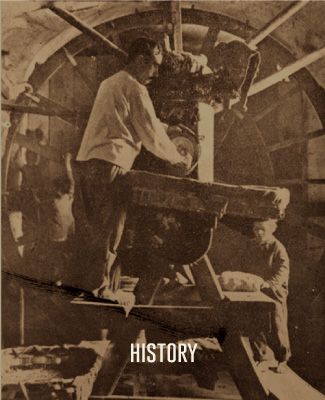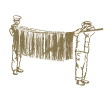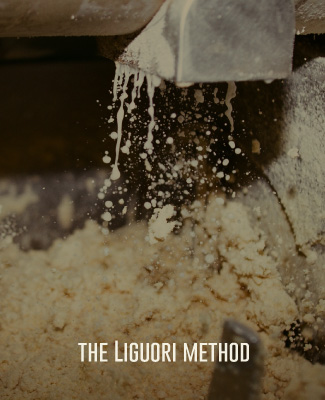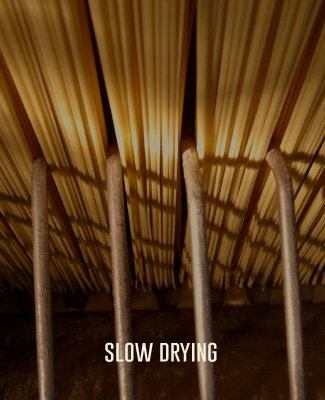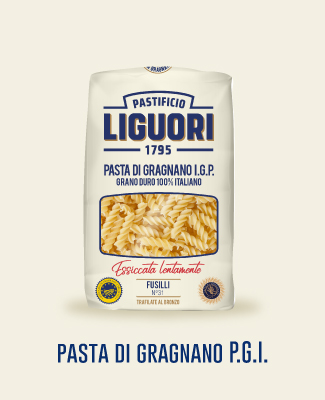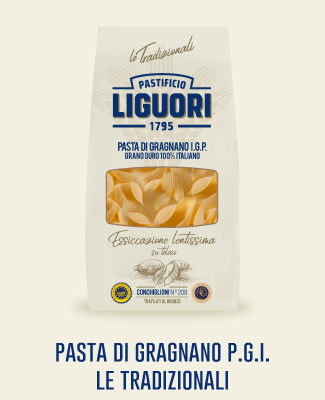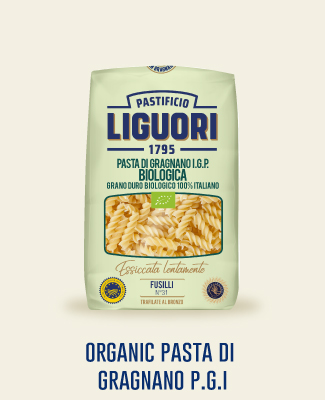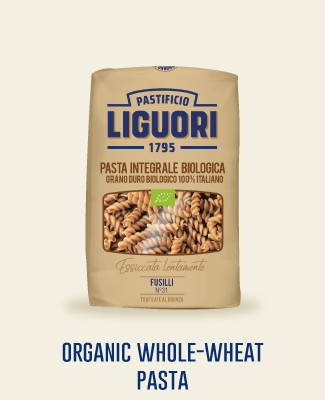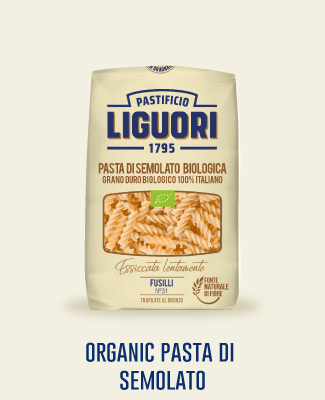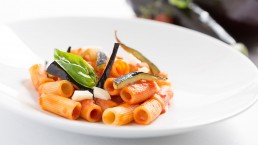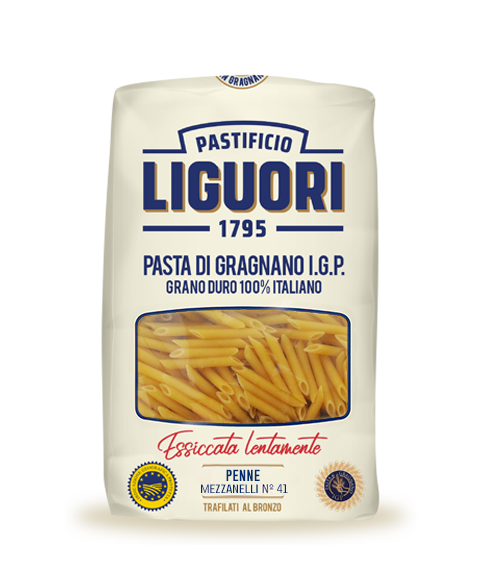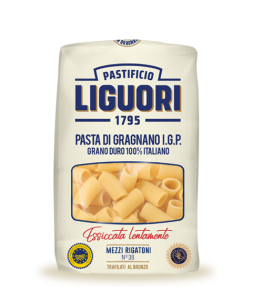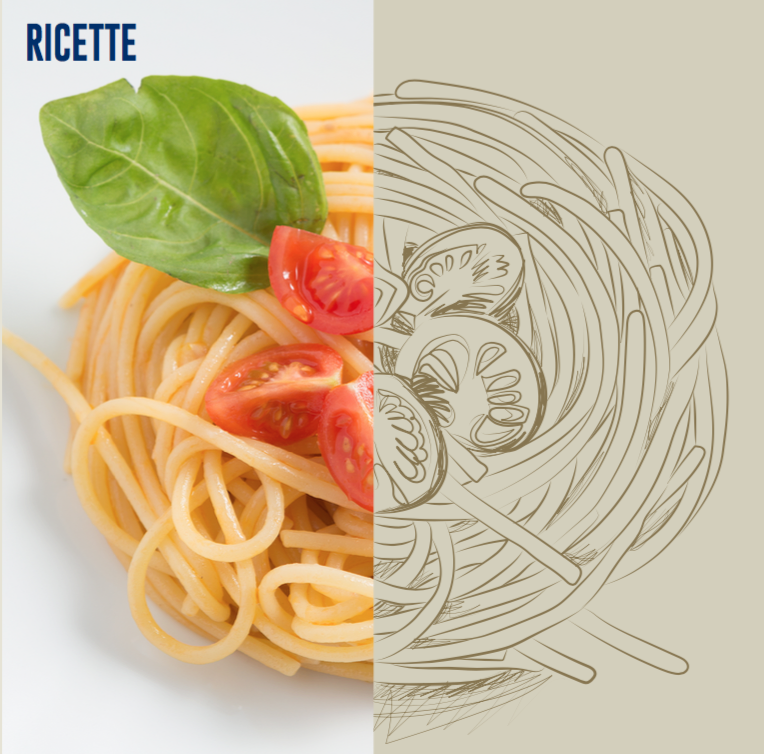The new eco pack
The new eco pack
Pastificio Liguori changes its look, not only with a focus on restyling and repositioning the brand, but above all by virtue of its commitment to sustainability and eco-compatibility.
At a time when respect for nature is a burning issue, the priority of any large company is to create recyclable, compostable and environmentally friendly products and develop production systems that reduce the impact on the environment.
Liguori expresses its attention to environmental issues first of all respecting the production and processing cycles of Italian durum wheat that it uses for the production of pasta. The company's commitment is also reflected in an eco-sustainable development that reduces CO2 emissions and, above all, in the creation of a recyclable paper pack with the Aticelca 501 certification and recyclable packaging with the FSC certification.
Pasta Liguori: nice, good and nature friendly.
The reason we're "the first" since two centuries
The reason we're "the first" since two centuries
The history of the city of Gragnano has always been closely linked to that of pasta. In this relationship that has lasted for centuries, at the end of the 18th century, we meet the Pastificio Liguori which almost becomes the symbol of the good pasta produced in Gragnano and its rich and fascinating tradition.
On August 16, 1795, the Council of the Municipality of Gragnano granted Gaetano Liguori the right to manufacture and sell good quality macaroni with the obligation of keeping a shop open for the convenience of the citizens. It was an artisan production not yet mechanized. The concession was for a consideration of 60 ducats, to be paid into the municipal funds, but it gave the right to directly fine those who abusively practiced the art of the macaroni maker.
IIn the early 1800s, the Council of the Municipality liberalised the possibility of making pasta for all citizens of Gragnano, given the crisis in other production sectors such as the manufacture of cloths and the destruction of silk activities, following an epidemic that hit the worms. Another pillar of Gragnano's economy was represented since the 13th century by the milling of cereals, with numerous mills using the power of the spring water of the Monti Lattari basin. The people of Gragnano were therefore well acquainted with the various semolina and flours, and chose the most suitable ones to offer a high quality pasta..
Documents handed down by the Liguori family identify the foundation of a macaroni factory in 1820. In the 1900's, Pastificio Liguori combined its name with this year of foundation. On July 12, 1845, among the personalities who welcomed the Bourbon king Ferdinand II on a visit to the city, we find Giuseppe Liguori. After visiting Gragnano and listening to a solemn mass in the monumental church of del Corpus Domini, the king visited the pasta factories and tasted the pasta. He was enthusiastic about it and granted the Liguori pasta factory in Gragnano the privilege of supplying pasta for the royal residence of Quisisana,where he spent his summer holidays with his entire court. During that day, the king walked accompanied by 40 knights along Corso Sancho, now Via Roma, which had just been transformed to allow the pasta to be dried outdoors. The Liguori long pasta factory was right in the middle of that road, perfectly aligned with the East-West axis to take full advantage of the breezes that came from the sea (located just 3 kilometers) and the Lattari mountains, breezes that alternated during the day, allowing the pasta to dry slowly.
Rigatoni alla siciliana

Rigatoni alla siciliana
Rigatoni alla siciliana is one of the most famous dishes of the Italian culinary tradition, rich in flavor, born from the combination of fried eggplants, tomatoes and provola. Simple, colorful, delightful, this dish never disappoints! Just a few ingredients easy to find and a little elaborate preparation to bring to the table all the flavor of the south. What’s the secret to best enjoy it? Rigatoni PGI Liguori , a format that holds the sauce in an inimitable way.

_____________________________________________________________________________________________________________________________________________
The Liguori advice
To remove the vegetation water from the eggplants and ensure a crisp result, it is useful to leave the eggplants previously washed and cut, for 30 minutes sprinkled with plenty of coarse salt under a weight (a plate, a bowl). Then just dry them and remove the excess salt with a kitchen towel.
_____________________________________________________________________________________________________________________________________________
Cut the eggplants into cubes, then fry them in a high-sided pot, little by little, in plenty of hot oil. Keep the aubergines aside and prepare the sauce: in a saucepan fry a clove of crushed garlic and 5 tablespoons of oil, brown and add the tomato sauce, salt and pepper. Cover and leave to cook for about 25 minutes. Season with salt and make the water boil, cook the rigatoni for 13 minutes or, if you prefer to cook al dente, for 12 minutes.
Meanwhile, remove the garlic from the sauce and add the eggplants. Drain the pasta, put it back in the pot and add the sauce. Add the cubes of provola, the parmesan cheese, plenty of basil, mix over low heat so that the provola melts and serve with some fried eggplant kept aside and a leaf of fresh basil.



